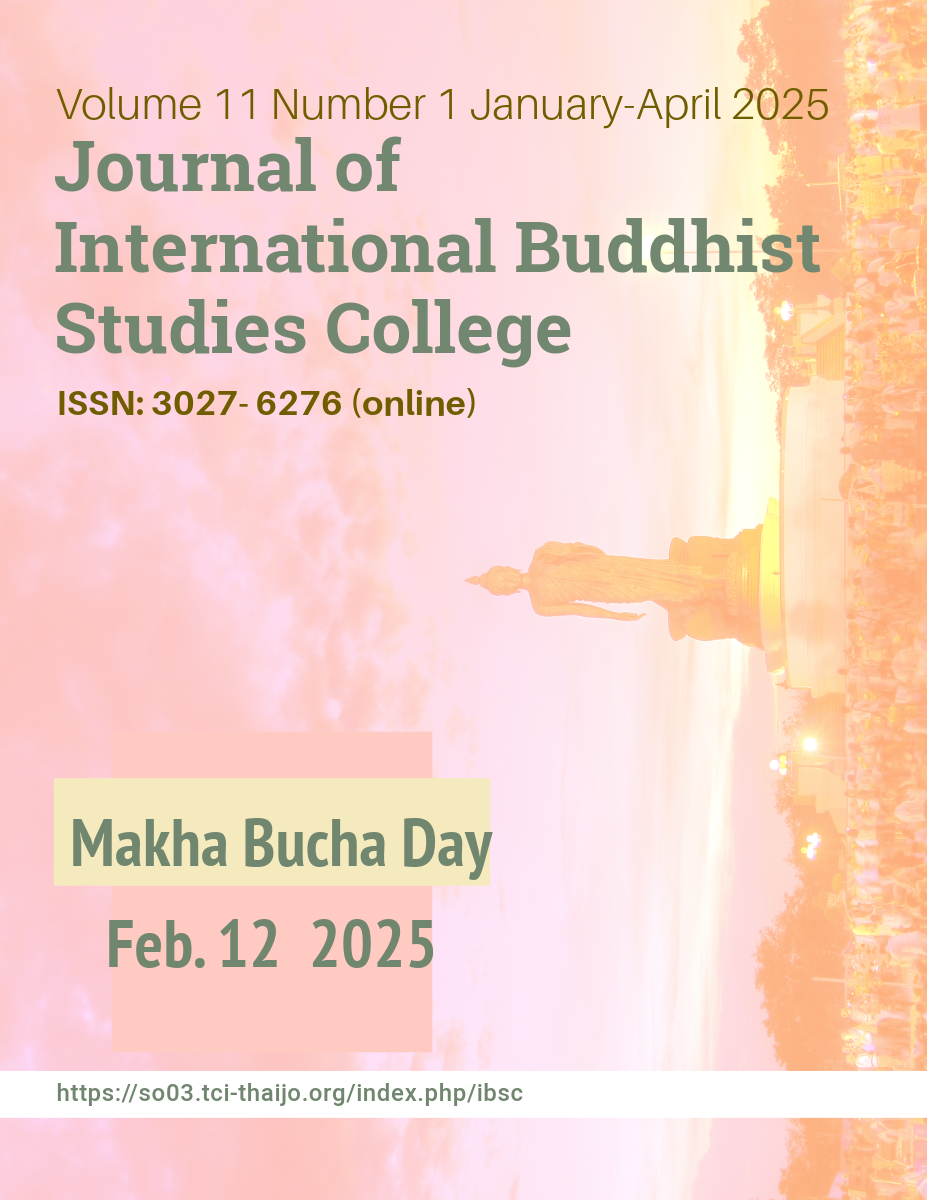The Way to Pace: Living according to the Buddhist Five Precepts in Myanmar
Keywords:
The Way to Peace, The Buddhist Five Precepts, Myanmar BuddhismAbstract
This article comprehensively explores the potential for peacebuilding in Myanmar through the practice of the Buddhist Five Precepts. It investigates the underlying causes of conflict and unrest within the country, framing these issues within the context of Buddhist teachings. Emphasizing the significance of the Five Precepts, these moral guidelines can serve as a foundational framework for addressing Myanmar's multifaceted societal challenges, including political instability, ethnic strife, governance failures, economic difficulties, educational deficits, public health crises, and endemic violence.
The study analyzes Myanmar's historical and cultural landscape, highlighting how entrenched societal norms perpetuate a cycle of discord. Examining past conflicts reveals that applying the Five Precepts can facilitate personal transformation and societal healing. The Precepts, while traditionally viewed as ethical guidelines for lay Buddhists, possess the capacity to unify diverse communities and promote peace.
Furthermore, this article advocates for integrating Buddhist teachings into educational curricula and community initiatives to cultivate open dialogue, mutual respect, and collaboration among conflicting parties in Myanmar. By emphasizing the principles of compassion, mindfulness, and ethical conduct, it seeks to bridge divides and facilitate understanding in a society marred by tension and discord. Ultimately, it argues that the intentional practice of the Buddhist Five Precepts offers a viable and effective strategy for achieving sustainable peace in Myanmar, enhancing individual well-being, and promoting collective harmony. Pursuing "Living the Buddhist Five Precepts" emerges as a critical and practical endeavor in addressing the ongoing challenges to peace in the region. By instilling these principles in both personal lives and community frameworks, we can nurture a culture of peace that holds the potential to transform conflict into cooperation, ultimately leading to a more harmonious society.
References
Abreha, R. (2020). The concept of peace, violence, and conflict. Ethiopian Activity. Early impacts of the Myanmar political crisis on rural farm households: Findings from March. https://doi.org/10.2499/P15738 COLL2.134417
Clayton, G., & Sticher, V. (2021). The logic of ceasefires in civil war. International Studies Quarterly. https://doi.org/10.1093/ISO/SQAB026
Eberle, M., & Holliday, I. (2011). Precarity and political immobilization: Migrants from Burma in Chiang Mai, Thailand. Journal of Contemporary Asia, 41(3), 371–392. https://doi.org/10.1080/00472336.2011.582709
Faxon, H., Kintzi, K., Tran, V., Wine, K., & Htut, S. (2023). Organic online politics: Farmers, Facebook, and Myanmar's military coup. Big Data & Society, 10. https://doi.org/10.1177/20539517231168101
Galtung, J. (1969). Violence, peace, and peace research. Journal of Peace Research, 6(3), 167–191.
Ganesan, N. (2017). Appraising Myanmar's democratic transition and evolving challenges. Japanese Journal of Political Science, 18, 196–215. https:// doi.org/10.1017/S1468109916000372
Isarovuthakul, S. (Trans.). (1969). True peace (Vol. II). Speech of Disaku Ikeda. Songsiam.
Khantipalo Bhikkhu. (1989). Buddhism explained. Silkworm Books.
Lin, H. (2023). Educational challenges and expectancy of non-governmental education leaders in armed conflict areas in Myanmar. International Journal of Educational Management and Development Studies. https://doi.org/10.53378/353022
Manurung, H. (2021). Myanmar political instability: A threat to Southeast Asia stability. Journal Asia Pacific Studies. https://doi.org/10.33541/japs. v5i1.2671
Miller, C., & King, M. (2003). A glossary of terms and concepts in peace and conflict studies. University for Peace.
Myanmar Agriculture Policy Support Activity. (2021). Early impacts of the Myanmar political crisis on rural farm households: Findings from March 2021. https://doi.org/10.2499/P15738COLL2.134417
Nagai, M. (Trans.). (1969). Buddhaghosa’s commentary on the Viniyapitaka (Vol. II). The Pali Text Society.
Norman, H. C. (Trans.). (1970). The commentary on the Dhammapada (Vol. I). The Pali Text Society.
Phra Thepsophon, (2000). A Buddhist worldview. Mahachulalongkornrajavid yalaya University Press.
Phra Sunthorn Plamintr. (1999). Basic Buddhism course. Buddha Publishing.
Rao, M., Htun, S., Platt, S., Tizard, R., Poole, C., Myint, T., & Watson, J. (2013). Biodiversity conservation in a changing climate: A review of threats and implications for conservation planning in Myanmar. AMBIO, 42, 789–804. https://doi.org/10.1007/s13280-013-0423-5
Rhys Davids, C. A. F. (Trans.). (1975). The Visuddhi-Magga of Buddhaghosa. The Pali Text Society.
Simoniya, A. (2020). Myanmar a year after the military coup. Southeast Asia: Actual Problems. https://doi.org/10.31696/2072-8271-2022-2-2-55-136-150
Thawnghmung, A., & Noah, K. (2021). Myanmar’s military coup and the elevation of the minority agenda? Critical Asian Studies, 53, 297–309. https://doi.org/10.1080/14672715.2021.19122620
Toffler, A. (2000). War and peace in the 21st century. Nanmee Book.
Ven. Nyanika. (2020). The Buddhist approach to establishing peace through the Five Precepts. Sri Lanka International Buddhist Academy (SIBA). International Journal of Science and Research, 9(1).
Rahula, W. (1959). What the Buddha taught. The Gordon Fraser Gallery.
Yeh, T. D. (2006). The way to peace: A Buddhist perspective. International Journal of Peace Studies, 11(1).
Zaw, H. (2018). Conflict resolution and peacebuilding: The long-lasting trauma of Myanmar. Advances in Journalism and Communication, 6, 121–138. https://doi.org/10.4236/ajc.2018.64010
Downloads
Published
How to Cite
Issue
Section
License
The Journal of TCI is licensed under a Creative Commons Attribution-NonCommercial-NoDerivatives 4.0 International (CC BY-NC-ND 4.0) licence unless otherwise stated. Please read our Policies page for more information on Open Access, copyright and permissions.





